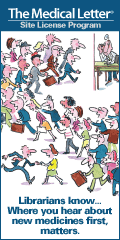

MLA Position Statements and FAQs
The Role of Health Sciences Librarians
in Telemedicine Position Statement
 MLA's Position
MLA's Position
The Medical Library Association (MLA) views telemedicine as an important new way to incorporate the information and knowledge management expertise of health sciences librarians in the health care, research and education missions of hospitals, schools and other health organizations. Health sciences librarians can play leadership roles in planning, organizing, and implementing telemedicine programs. As members of telemedicine teams, health sciences librarians work to assure that telemedicine participants have well-integrated, comprehensive access to knowledge-based health information resources and services.
 Why MLA Supports this Position
Why MLA Supports this Position
Librarians are knowledge workers and thus "are uniquely equipped to understand and provide linkages between information resources and those who seek assistance" [1]. In today's Information Age and tomorrow's Knowledge Age, health sciences librarians are and will continue to be information technology leaders, enlarging and redefining the role of the library. Telemedicine programs are poised to generate new information and knowledge management paradigms, and health sciences librarians are well prepared for the resulting changes in the landscape of the "library without walls."
 Background
Background
Telemedicine is a widely used term for activities that incorporate aspects of clinical practice, teaching, and research for the exchange of health care information across a distance. Not limited to the field of medicine, telemedicine or telehealth is multidisciplinary, including all health-related disciplines. Telemedicine includes such activities as consultations between practitioners and patients (e.g. home health care visits), interactions between instructors and students (e.g. distance education and continuing medical education), and consumer interactions with remote electronic information resources (e.g. "the library without walls").
Telemedicine uses multifunctional technologies including the World Wide Web, online information search and delivery, and high bandwidth, real-time video imaging distribution systems. The information exchanged via these technologies include the real-time expertise of health care practitioners, patient records, diagnostic images, and the knowledge-based information resources traditionally associated with libraries.
Telemedicine is a strategy for meeting the regional and national health policy goals of serving the needs of rural or other isolated populations. Telemedicine programs increase the potential client base for health sciences library resources and services, extending information resources and services to larger and more diverse constituencies and to expanded geographic regions. This implies a greater use of electronic means of interaction between health sciences libraries and their clients. It provides opportunities to deliver information at the point of service, potentially even into patient residential settings.
 MLA Goals and Recommendations
MLA Goals and Recommendations
MLA supports the integration of library resources and services with telemedicine initiatives by advocating, communicating and collaborating with other professional organizations and government agencies. MLA, along with the National Library of Medicine, and in conjunction with organizations such as the Association of American Medical Colleges and American Medical Informatics Association, will help to frame telemedicine discussions and will work to foster synergistic opportunities for health care, research, and education institutions arising from these new knowledge management paradigms.
MLA supports additional funding for the National Library of Medicine to develop innovative new strategies and technologies to evaluate and to integrate library resources and information services into telemedicine programs.
MLA supports the professional development of librarians who value action and who frame the environment of change in their institutions' telemedicine planning. Librarians have the expertise and values needed to ensure that telemedicine resources are not "isolated from other forms of information management and data exchange" [2]. Health sciences librarians will work together with information technology designers, instructional designers, clinicians, and administrators to implement telemedicine programs and projects.
 Two Telemedicine Projects
Two Telemedicine Projects
The Arizona Telemedicine Program uses telecommunications links, high-resolution video imaging and advanced computer workstations to share the wealth of health care talent and knowledge resources at the Health Sciences Center in Tucson, AZ, with rural communities throughout the state. For more information about the program, visit the ATP Website.
The National Laboratory for the Study of Rural Telemedicine at the University of Iowa College of Medicine is conducting a series of five telemedicine research projects in the areas of diabetes, vascular ischemia, children with disabilities, pediatric echocardiograms, and psychiatric services to rural areas. Major funding for these projects is being provided through a contract with the National Library of Medicine. For more information about these projects, see the National Laboratory Website.
 Conclusion
Conclusion
Telemedicine provides many opportunities for health sciences librarians to demonstrate their unique information and knowledge management skills. Health sciences libraries and librarians will provide critical leadership and expertise for telemedicine and other distance health service programs, working to integrate knowledge-based resources and services into the full range of resources and technologies supporting health care, research and education. Below are two telemedicine projects in which health sciences librarians are partners in the delivery of telemedicine programs in their regions.
 References
References
1. Guise NB, et al. Preparing librarians to meet the challenges of today's health care environment. JAMIA 1997:4(1):57-67.
2. Hassol A, et al. Rural telemedicine data/image transfer methods and purposes of interactive video sessions. JAMIA 1997:4(1):36-37.
 Authors
Authors
Prepared by
Gary Byrd, SUNY at Buffalo Health Sciences Library, Buffalo, NY;
J. Roger Guard, University of Cincinnati Medical Center Libraries,
Cincinnati, OH; and
Theodore A. Morris, University of Cincinnati Medical Center Libraries,
Cincinnati, OH.
For further information, contact Mary Langman, 312.419.9094 x27.
Medical Library Association
312.419.9094
info@mlahq.org
© 1999-2008 Medical Library Association
Send site questions/comments to systems administrator
Last Updated: 2007 July 13
www.mlanet.org/government/positions/telemedicine.html





